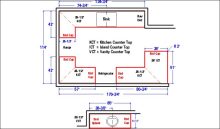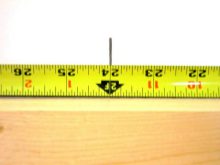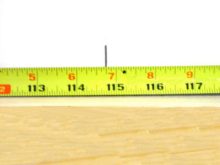Measure Existing
Contact UsMeasuring Existing Cabinets
Make an outline sketch of what the countertops look like (fig.1).
If the countertops fit well and no adjustments are needed proceed as follows; Using a good quality steel tape measure, make sure the tip is 90° to the blade (not bent). Take measurements along the wall of all the existing countertops.
Measure existing island countertop length from end to end of the island. Measure across the island to determine the width. If the countertop butts into a wall put the end of tape up against the wall and take measurements on the exposed end.
If measuring between walls place the end of the tape in the right corner with tip touching wall, measure out 24″ and put a pencil mark on the wall (fig. 2), then put the end of the tape in the left corner with tip touching wall and measure to pencil line (fig. 3), write down this measurement and add 24″ (example 114-3/4″ + 24″ = 138-3/4″).
As you get measurements write them down on the sketch you drew previously.
Also, make note of ends that get finished (capped) or may need a radius, etc.
You also may need front cabinet measurements. This would apply to diagonal corner cabinets, angle-end base cabinets, etc. Sometimes countertops with odd angles or nonstandard widths may need a template made before the countertop can be manufactured and cut.
Typical Countertop Overhang
- 0″ Next to stove.
- 1/4″ Next to refrigerator.
- 3/4″ Exposed end of kitchen countertop.
- 1/2″ Exposed end of vanity countertop.
- 1-1/2″ Exposed end of island countertop, with no radius.
- 1/2″+ radius size Exposed end of island countertop, with radius. (example 6″ radius; 6″ + 1/2″ = 6-1/2″)



